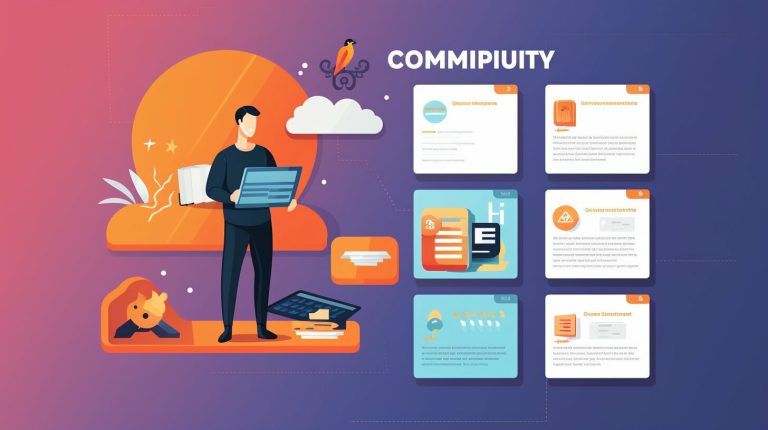Unveiling the Concept: What is Virtualization?
Virtualization is a groundbreaking technology that revolutionizes the way we use and manage computer resources. It involves creating virtual machines (VMs) that mimic the functionality of physical computers, running their own operating systems and software. By utilizing a single, physical hardware system, virtualization allows you to create multiple simulated environments or dedicated resources.
With virtualization, you can maximize resource utilization, increase efficiency and flexibility, and reduce costs. It enables you to consolidate multiple virtual machines on a single physical machine and easily move or allocate resources between environments. Virtualization is changing the way we think about computing, bringing a new level of efficiency and scalability to IT infrastructure and operations.
Key Takeaways:
- Virtualization allows for the creation of multiple simulated environments or dedicated resources from a single, physical hardware system.
- Virtual machines (VMs) mimic the functionality of physical computers and run their own operating systems and software.
- Virtualization increases efficiency and flexibility while reducing costs.
- Consolidating multiple virtual machines on a single physical machine maximizes resource utilization.
- Virtualization is revolutionizing IT infrastructure and operations.
Demystifying Virtualization: The Magic Behind the Technology
Virtualization is a powerful technology that comes in various forms, each with its own unique benefits and use cases. Let’s explore the different types of virtualization and understand the magic behind this transformative technology.
Type of Virtualization: Full Virtualization
In full virtualization, a hypervisor creates multiple virtual machines (VMs) that mimic the functionality of physical computers. Each VM runs its own operating system and applications, isolated from other VMs and the underlying hardware. This type of virtualization provides the highest level of compatibility and flexibility, making it ideal for running a wide range of software and operating systems.
Type of Virtualization: Para-virtualization
Para-virtualization involves modifying the guest operating system to work in collaboration with the hypervisor. This enables faster communication and resource sharing between the guest OS and the underlying hardware. Para-virtualization offers improved performance compared to full virtualization but requires software modifications, making it limited to certain operating systems and applications.
Type of Virtualization: Hardware-assisted Virtualization
Hardware-assisted virtualization leverages the capabilities of modern processors to optimize virtualization performance. Processors with hardware-assisted virtualization features, such as Intel VT-x and AMD-V, offload some of the virtualization tasks to the hardware, resulting in better resource utilization and performance. This type of virtualization is widely used in enterprise environments and data centers.
| Type of Virtualization | Key Features | Use Cases |
|---|---|---|
| Full Virtualization | Complete isolation, compatibility, flexibility | Running multiple operating systems and software on a single server |
| Para-virtualization | Improved performance, limited software compatibility | High-performance computing, certain Linux distributions |
| Hardware-assisted Virtualization | Optimized performance, hardware acceleration | Data centers, enterprise virtualization |
Virtualization technology and virtual machines have revolutionized the IT industry by allowing businesses to maximize resource utilization, reduce costs, and improve flexibility. Benefits of virtualization include:
- Efficient resource utilization: Multiple VMs can run on a single physical server, reducing hardware requirements and energy consumption.
- Cost-effectiveness: Virtualization eliminates the need for separate physical servers for each application, reducing capital and operational expenses.
- Flexibility: VMs can be easily scaled up or down based on demand, allowing for efficient resource allocation.
- Improved security and risk reduction: Isolated VMs prevent malware and vulnerabilities from spreading across the system, increasing overall security.
Virtualization is a game-changer in the IT world, unlocking new possibilities and transforming the way we utilize and manage computer resources. By understanding the different types of virtualization and the benefits they offer, businesses can harness the power of this technology to optimize their operations and drive innovation.
Understanding the Concept: What is Virtualization?
Virtualization is a fundamental concept in modern computing that involves creating virtual versions of physical resources, such as servers, storage devices, network resources, or operating systems. It revolutionizes the way we think about computing by allowing us to consolidate multiple virtual machines onto a single physical machine, maximizing resource utilization and reducing costs.
The concept of virtualization is based on the use of a hypervisor, a software layer that abstracts the physical hardware and manages the allocation of resources to each virtual machine. This enables the creation of virtual machines that run their own operating systems and applications, isolated from each other and the host system. By decoupling the software from the underlying hardware, virtualization provides greater flexibility, efficiency, and scalability.
Virtualization technology has transformed the IT industry, enabling organizations to streamline their infrastructure, optimize resource allocation, and improve overall efficiency. It offers numerous benefits, including cost savings, simplified management, improved security, and increased flexibility. With virtualization, businesses can easily scale their computing resources, quickly deploy new applications, and enhance disaster recovery capabilities. Furthermore, virtualization provides a safe environment for testing new software or configurations, minimizing the risk of disruptions in production environments.
Overall, virtualization is a powerful technology that has become indispensable in today’s digital landscape. It empowers organizations to fully leverage their computing resources, enhance agility, and unlock new possibilities for innovation.
| Benefits of Virtualization | Implications of Virtualization |
|---|---|
|
|
Virtualization is a key enabler of modern IT infrastructure, driving innovation and providing a solid foundation for digital transformation. As technology continues to evolve, virtualization will continue to play a crucial role in shaping the future of computing.
Different Types of Virtualization
Virtualization encompasses various types, each serving different purposes and offering unique benefits. Some of the key types of virtualization include:
- Network virtualization: Allows for the creation of virtual networks that are independent of the underlying physical network infrastructure.
- Desktop virtualization: Enables the delivery of virtual desktops to end-users, providing flexibility and centralized management.
- Storage virtualization: Abstracts physical storage devices and allows for efficient allocation and management of storage resources.
- Data virtualization: Combines data from multiple sources into a single virtual view, simplifying data integration and access.
- Application virtualization: Packages applications and their dependencies into isolated containers, enabling seamless deployment and management.
- Data center virtualization: Involves virtualizing the entire data center infrastructure, including servers, storage, and networking.
- Hardware virtualization: Refers to the virtualization of physical hardware resources, such as processors and memory, for efficient resource utilization.
Each type of virtualization offers its own set of benefits and brings additional efficiencies to different aspects of IT infrastructure and operations. By leveraging the right types of virtualization, organizations can optimize their IT resources, improve agility, and drive innovation in their digital journey.
Exploring the Virtual Machine (VM) and Its Components
A virtual machine (VM) is a simulated computer that exists within a physical computer. It is composed of several components that replicate the functionality of their physical counterparts. These components include the virtual CPU (vCPU), virtual memory, virtual disk, and virtual network interface card (vNIC). Together, they allow the virtual machine to operate independently, running its own operating system and applications, while being isolated from other virtual machines and the host system.
The virtual CPU, or vCPU, is a virtualized version of the physical CPU. It enables the virtual machine to perform computational tasks just like a physical CPU would. The vCPU is allocated a certain amount of processing power from the physical CPU, allowing the virtual machine to run its applications and processes.
Virtual memory is the virtualized equivalent of physical memory. It provides the virtual machine with the necessary space to store and access data while running its applications. The virtual disk emulates the functionality of a physical hard disk, providing storage space for the virtual machine’s operating system, applications, and files. Finally, the virtual network interface card, or vNIC, enables the virtual machine to connect to networks and communicate with other devices.
| Component | Description |
|---|---|
| Virtual CPU (vCPU) | The virtualized version of the physical CPU, allowing the virtual machine to perform computational tasks. |
| Virtual Memory | The virtualized equivalent of physical memory, providing storage space for the virtual machine’s data and applications. |
| Virtual Disk | An emulation of a physical hard disk, serving as storage for the virtual machine’s operating system, applications, and files. |
| Virtual Network Interface Card (vNIC) | Enables the virtual machine to connect to networks and communicate with other devices. |
Virtual machines are the backbone of virtualization technology, enabling organizations to efficiently utilize their computer resources. By simulating the components of a physical computer, virtual machines provide the flexibility and isolation necessary for running multiple operating systems and applications on a single physical machine.
The components of a virtual machine work together to create an isolated and independent computing environment that can be easily managed and scaled as needed. This allows organizations to optimize their resource utilization, reduce costs, and improve overall operational efficiency.
The Advantages of Virtual Machines
Virtual machines offer several advantages that make them a powerful tool in modern computing environments. Firstly, they enable the consolidation of multiple virtual machines on a single physical machine, maximizing resource utilization and reducing hardware costs. By running multiple virtual machines on a single server, organizations can achieve higher efficiency and lower power consumption.
Secondly, virtual machines allow for easy migration and allocation of resources. Virtual machines can be easily moved from one physical server to another, providing flexibility and agility in resource management. Additionally, resources such as CPU and memory can be dynamically allocated to virtual machines based on their workload, ensuring optimal performance.
Lastly, virtual machines provide a secure and isolated environment for running applications. Each virtual machine operates independently, with its own operating system and applications. This isolation helps prevent the spread of malware or vulnerabilities from one virtual machine to another, enhancing overall security.
Overall, virtual machines play a crucial role in modern computing environments, offering flexibility, efficiency, scalability, and security. By leveraging the power of virtualization technology, organizations can unlock the full potential of their computer resources and drive innovation in their IT infrastructure.
The Power of Virtualization: Benefits and Implications
Virtualization offers a wide range of benefits that have revolutionized the IT industry. By leveraging virtual machines and the abstraction of physical resources, organizations can experience increased efficiency, cost savings, scalability, enhanced security, disaster recovery capabilities, and more.
Efficient Resource Utilization: Virtualization allows for the consolidation of multiple virtual machines on a single physical machine, maximizing resource utilization. This means that computing power, storage, and network resources can be efficiently allocated, eliminating the need for underutilized hardware and reducing costs.
Cost Savings: Virtualization can significantly reduce costs by eliminating the need for multiple physical servers and hardware components. With virtual machines running on a single physical machine, organizations can save on upfront infrastructure costs, power consumption, cooling, and maintenance.
“Virtualization allows organizations to do more with less, optimizing resource usage and improving the return on investment.”
Enhanced Security: Virtualization provides enhanced security through isolation. Each virtual machine operates independently, with its own operating system and applications, preventing any potential security breaches from spreading across the entire system. Additionally, organizations can implement granular security policies and easily apply patches and updates to individual virtual machines.
Disaster Recovery and Testing Environments: Virtualization enables organizations to create replica virtual machines that can be quickly restored in the event of a system failure or disaster. This ensures business continuity and minimizes downtime. Additionally, virtual machines can be used to create safe testing environments, allowing organizations to test new software, updates, or configurations without impacting their production systems.
While virtualization offers numerous benefits, it also presents some considerations. Organizations must implement proper management and monitoring practices to ensure optimal performance and security. Additionally, the increasing reliance on virtual infrastructure means that any disruption in the virtualization environment can have significant implications for business operations. To mitigate these implications, organizations should have a thorough understanding of virtualization technology and develop comprehensive disaster recovery plans.
Table: Benefits of Virtualization
| Benefits | Description |
|---|---|
| Efficient Resource Utilization | Maximize resource utilization by consolidating virtual machines |
| Cost Savings | Reduce upfront infrastructure costs, power consumption, and maintenance |
| Enhanced Security | Isolate virtual machines to prevent security breaches |
| Disaster Recovery and Testing Environments | Quickly restore virtual machines in the event of failures or create safe testing environments |

Virtualization offers numerous advantages for organizations looking to optimize their IT infrastructure. By harnessing the power of virtual machines and efficient resource allocation, businesses can realize cost savings, enhanced security, disaster recovery capabilities, and more. However, it is crucial for organizations to understand the implications and challenges associated with virtualization, such as proper management and monitoring practices, to ensure the smooth operation of their virtualized environments.
Unleashing the Potential: How Virtualization Works
Virtualization is a complex technology that operates through a well-defined process and mechanism. To understand how virtualization works, it is essential to grasp the underlying principles and components involved.
The virtualization process starts with the abstraction of physical hardware using a hypervisor. This software layer separates the physical resources from the virtual machines (VMs), allowing multiple VMs to be created and run on a single physical machine. The hypervisor manages the allocation of CPU, memory, storage, and network resources to each VM, ensuring smooth operation and isolation.
Within each VM, there are various components that enable its functioning. These include the virtual CPU (vCPU), virtual memory, virtual disk, and virtual network interface card (vNIC). Together, these components replicate the functionality of their physical counterparts but operate purely in software.
The virtualization mechanism facilitates the creation of virtual machines that run their own operating systems and applications, independent of other VMs and the host system. This allows for efficient resource utilization, improved flexibility, and the ability to run multiple VMs on a single physical machine.
By leveraging virtualization, organizations can achieve a range of benefits, including increased efficiency, cost savings, scalability, enhanced security, disaster recovery capabilities, safe testing environments, legacy software support, energy efficiency, streamlined management, and high availability. However, it is important to note that virtualization also brings its own set of challenges and considerations, such as security risks and the need for proper management and monitoring.
In summary, virtualization works by abstracting physical hardware through a hypervisor, creating virtual machines that run independent operating systems and applications. This technology unlocks the potential for efficient resource utilization, flexibility, and consolidation of multiple VMs on a single physical machine.
Types of Virtualization: Exploring the Possibilities
Virtualization goes beyond just creating virtual machines. It encompasses a range of virtualization types that revolutionize different aspects of IT infrastructure and operations. Let’s dive into some of the main types of virtualization and explore their possibilities.
1. Network Virtualization
Network virtualization allows you to create virtual networks that are decoupled from the physical network infrastructure. By abstracting network resources, organizations can optimize network utilization, improve security, and enhance network management. Virtual networks can be easily provisioned and scaled, empowering businesses to adapt quickly to changing network demands and configurations.
2. Desktop Virtualization
Desktop virtualization enables the delivery of virtual desktops to end-users, providing a secure and flexible computing environment. With desktop virtualization, individual desktop environments are hosted on a central server or the cloud, allowing users to access their desktops from any device. This type of virtualization enhances productivity, simplifies desktop management, and enhances data security by centralizing data storage and enforcing access controls.
3. Storage Virtualization
Storage virtualization abstracts physical storage devices into virtual pools, making it easier to manage and allocate storage resources. It enables organizations to consolidate storage infrastructure, improve storage efficiency, and simplify data management. By decoupling storage from physical hardware, storage virtualization provides greater flexibility, scalability, and data protection.
4. Data Virtualization
Data virtualization allows data from multiple sources and formats to be accessed, integrated, and presented as a single, unified data source. With data virtualization, organizations can gain a holistic view of their data, enabling faster and more accurate decision-making. It eliminates data silos, reduces data duplication, and simplifies data integration, making it easier to derive insights and value from diverse data sources.
5. Application Virtualization
Application virtualization allows applications to be decoupled from the underlying operating system, enabling them to run on different operating systems and environments. With application virtualization, organizations can streamline software deployment, improve compatibility, and reduce conflicts between applications. It simplifies application management, enhances security, and enables the efficient delivery of applications to end-users.
6. Data Center Virtualization
Data center virtualization involves pooling and abstracting computing, storage, and networking resources across multiple physical data centers. It enables organizations to optimize resource utilization, improve scalability, and enhance disaster recovery capabilities. Data center virtualization empowers businesses to create flexible, agile, and efficient data center environments that can adapt to changing business needs.
7. Hardware Virtualization
Hardware virtualization, also known as server virtualization, is the foundation of virtualization technology. It allows for the creation of virtual machines that mimic the functionality of physical servers. By abstracting physical hardware resources, hardware virtualization enables efficient resource utilization, improves flexibility, and simplifies server management. It enables businesses to run multiple virtual machines on a single physical server, reducing hardware costs and maximizing server performance.
| Type of Virtualization | Main Benefits |
|---|---|
| Network Virtualization | Improved network management, enhanced security, and scalability |
| Desktop Virtualization | Increased productivity, simplified desktop management, and enhanced data security |
| Storage Virtualization | Better storage efficiency, simplified data management, and improved scalability |
| Data Virtualization | Unified view of data, faster decision-making, and simplified data integration |
| Application Virtualization | Easier software deployment, improved compatibility, and enhanced application management |
| Data Center Virtualization | Optimized resource utilization, improved scalability, and enhanced disaster recovery |
| Hardware Virtualization | Efficient resource utilization, increased flexibility, and simplified server management |

Virtualization encompasses a range of types, including network virtualization, desktop virtualization, storage virtualization, data virtualization, application virtualization, data center virtualization, and hardware virtualization. Each type offers unique benefits and possibilities, transforming different aspects of IT infrastructure and operations. By harnessing the power of these virtualization technologies, organizations can optimize resource utilization, improve flexibility, enhance security, and enable more efficient and scalable IT environments.
The Future of Virtualization: Advancements in Virtualization Technology
Virtualization has come a long way since its inception, and the future looks incredibly promising. Advancements in virtualization technology continue to push the boundaries of what is possible, revolutionizing the way we utilize computer resources. As we delve into the future of virtualization, let’s explore some of the key advancements that are shaping this transformative technology.
1. Containerization: Streamlining Resource Utilization
Containerization is one of the most significant advancements in virtualization technology. Unlike traditional virtualization, which relies on creating virtual machines, containerization allows for the creation of lightweight, isolated environments known as containers. These containers share the host operating system, eliminating the need for a separate guest operating system, resulting in improved resource utilization and faster deployment times. With containerization, organizations can scale their applications more efficiently and achieve greater flexibility in managing their infrastructure.
2. Edge Computing: Bringing Virtualization to the Edge
The rise of edge computing is another game-changing development in the virtualization landscape. Edge computing involves processing data closer to its source, reducing latency and optimizing network bandwidth. Virtualization plays a crucial role in enabling edge computing by abstracting the underlying hardware and allowing for the deployment of virtual resources at the network edge. This technology enables real-time data processing, enhanced security, and localized decision-making, opening up possibilities for applications in industries such as IoT, autonomous vehicles, and remote healthcare.
3. Hybrid Cloud: Bridging On-Premises and Cloud Environments
The hybrid cloud model, combining both on-premises infrastructure and cloud-based services, has gained significant popularity. Virtualization technology plays a critical role in enabling the seamless integration and management of these hybrid environments. With advancements in virtualization, organizations can easily move workloads between on-premises data centers and public or private clouds, leveraging the benefits of both. This flexibility allows businesses to optimize costs, scale resources as needed, and efficiently manage their infrastructure across multiple environments.
Conclusion
Virtualization is a revolutionary technology that allows for the efficient and flexible use of computer resources. By creating virtual machines, virtual networks, and virtual storage, virtualization has transformed the way we think about computing. Its numerous benefits and implications have made it a cornerstone of modern IT infrastructure.
With virtualization, organizations can maximize resource utilization, reduce costs, and increase flexibility. It offers improved security, disaster recovery capabilities, and safe testing environments. Virtualization also allows for legacy software support, energy efficiency, streamlined management, and high availability.
Looking to the future, virtualization will continue to evolve and advance. As technology progresses, we can expect even more innovative solutions in IT infrastructure and operations. Virtualization has proven its value, and its role in shaping the future of computing is undeniable.
FAQ
What is virtualization?
Virtualization is a technology that allows you to create multiple simulated environments or dedicated resources from a single, physical hardware system.
What are the different types of virtualization?
Virtualization can be categorized into different types, such as full virtualization, para-virtualization, and hardware-assisted virtualization.
What are virtual machines?
Virtual machines are simulated computers within a physical computer, consisting of virtual CPUs, virtual memory, virtual network interfaces, and virtual disk storage.
What are the advantages of virtualization?
Virtualization offers increased efficiency, cost-effectiveness, flexibility, improved security and risk reduction, and the ability to easily move or allocate resources between environments.
How does virtualization work?
Virtualization works by abstracting the physical hardware through a hypervisor, creating virtual machines that run independent operating systems and applications.
What are the different types of virtualization?
Virtualization encompasses various types, such as network virtualization, desktop virtualization, storage virtualization, data virtualization, application virtualization, data center virtualization, and hardware virtualization.
What are the benefits of virtualization?
Virtualization offers efficient resource utilization, cost savings, scalability, enhanced security, disaster recovery capabilities, safe testing environments, legacy software support, energy efficiency, streamlined management, and high availability.
What is the future of virtualization?
As technology advances, virtualization will evolve to meet new challenges and pave the way for innovative solutions in IT infrastructure and operations.
- About the Author
- Latest Posts
Mark is a senior content editor at Text-Center.com and has more than 20 years of experience with linux and windows operating systems. He also writes for Biteno.com






